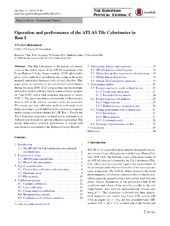Operation and performance of the ATLAS Tile Calorimeter in Run 1
Aaboud, Morad; Aad, Georges; Abbott, Brad; Abdallah, Jalal; Abdinov, Ovsat Bahram oglu; Abeloos, Baptiste; Abhayasinghe, Deshan Kavishka; Abidi, Syed Haider; AbouZeid, Hass; Abraham, Nadine L.; Buanes, Trygve; Eigen, Gerald; Fomin, Nikolai; Lipniacka, Anna; Martin dit Latour, Bertrand; Mæland, Steffen; Stugu, Bjarne; Yang, Zongchang; Zalieckas, Justas; Bugge, Magnar Kopangen; Cameron, David Gordon; Catmore, James Richard; Feigl, Simon; Franconi, Laura; Garonne, Vincent; Gramstad, Eirik; Hellesund, Simen; Morisbak, Vanja; Oppen, Henrik; Ould-Saada, Farid; Pedersen, Maiken; Read, Alexander Lincoln; Røhne, Ole Myren; Sandaker, Heidi; Serfon, Cédric; Stapnes, Steinar; Vadla, Knut Oddvar Høie; Abramowicz, Halina; Abreu, Henso; Abulaiti, Yiming; Acharya, Bobby S.; Adachi, Shunsuke; Adamczyk, Leszek; Adelman, Jareed; Adersberger, Michael; Adigüzel, Aytül; Adye, Tim; Affolder, Anthony Allen; Afik, Yoav; Agheorghiesei, Catalin; Zwalinski, L; ATLAS, Collaboration
Peer reviewed, Journal article
Published version

Åpne
Permanent lenke
https://hdl.handle.net/1956/19922Utgivelsesdato
2018-11-30Metadata
Vis full innførselSamlinger
Originalversjon
https://doi.org/10.1140/epjc/s10052-018-6374-zSammendrag
The Tile Calorimeter is the hadron calorimeter covering the central region of the ATLAS experiment at the Large Hadron Collider. Approximately 10,000 photomultipliers collect light from scintillating tiles acting as the active material sandwiched between slabs of steel absorber. This paper gives an overview of the calorimeter’s performance during the years 2008–2012 using cosmic-ray muon events and proton–proton collision data at centre-of-mass energies of 7 and 8 TeV with a total integrated luminosity of nearly 30 fb −1 . The signal reconstruction methods, calibration systems as well as the detector operation status are presented. The energy and time calibration methods performed excellently, resulting in good stability of the calorimeter response under varying conditions during the LHC Run 1. Finally, the Tile Calorimeter response to isolated muons and hadrons as well as to jets from proton–proton collisions is presented. The results demonstrate excellent performance in accord with specifications mentioned in the Technical Design Report.
